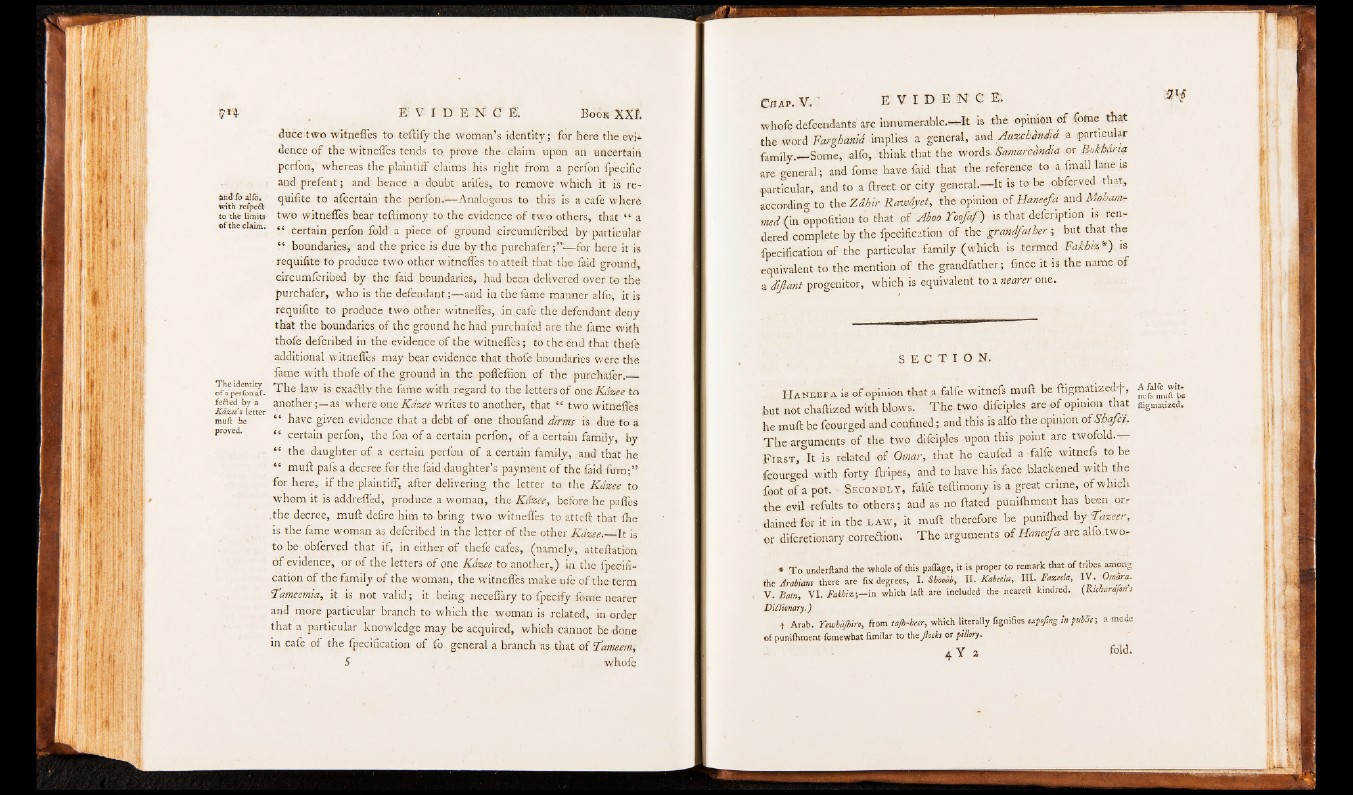
duce two witnefles to teftify the woman's identity; for here the evidence
of the witnefles tends to. prove the claim upon an uncertain
perfon, whereas the plaintiff claims his right from a perfon fpecific
and prefent j and hence a doubt ar-ifcs, to remove which it is re-
and fo alto, quifite to afcertain the perfon.— Analogous to this is a cafe where
with refpeft 1 °
to the limits two witnefles bear teftimony to the evidence of two others, that “ a
of the claim. 4t certain perfon fold a piece of ground circumfcribed by particular
“ boundaries, and the price is due by the purchafer;”— for here-it is
requifite to produce two other witnefles to atteft that the- faid e-round,
circumfcribed by the faid boundaries, had been delivered oyer to the
purchafer, who is the defendant;— and in the fame manner alfo, it is
requifite to produce two other witnefles, in cafe the defendant deny
that the boundaries of the ground he had purchafed are the fame with
thofe defcribed in the evidence of the witnefles; to the end that thefe
additional witnefles may bear evidence that thofe boundaries were the
fame with thofe of the ground in the poflefiion of the purchafer.—
rfaVerfonaf- The law is exaftly the fame with regard to the letters of one Kdzee to
fefledbya another;—as where one Kdzee writes to another, that “ two witnefles
Kaz.ee s letter , . . .
mull be have given evidence that a debt of one thouland dlrms is due to a
prove . “ certain perfon, the fon of a certain perfon, of a certain family, by
“ the daughter of a certain perfon of a certain family, and that he
' “ muft pafs a decree for the faid daughter’s payment of the faid firm;”
for here, if the plaintiff, after delivering the letter to the Kdzee to
whom it is addrefl'ed, produce a woman, the Kdzee, before he pafles
.the decree, muft defire him to bring- two witnefles to atteft that (he
is the fame woman as defcribed in the letter of the other Kdzee._It is
to be obferved that if, in either of thefe cafes, (namely, atteftation
of evidence, or of the letters of one Kdzee to another,) in the fperifi-
cation of the family of the woman, the witnefles make ufe of the term
fameemia, it is not valid; it being necefl'ary to fpecify fome nearer
and more particular branch to which the woman is related, in order
that a particular knowledge may be acquired, which cannot be done
in cafe of the fpecification of fo general a branch as that of 1 ’ameem,
5 . whofe
C h a p . M R E V I D E N C E.
whofe defcendants are innumerable.— It is the opinionmf feme that
the word Farghania implies a general, and Auzchmdd .a particufef
family.— Some,, alfo, think that the words. Samarcdndia or Kokhana
are general; and feme have faid that the reference to a lmail lane is
particular, and to a ftreet or city general.— It is to be obferved that,
according to the Zdhir Rowdyet, the opinion of Haneefa and Mohamr
med (in oppofition to that of Aboo Toofaf) is that defcription is rendered
complete by the fpecification of the grandfather; but that the
fpecification of the particular family (which is termed Fdkhiz*') is
equivalent to the mention of the grandfather; fince it is the name of
a dijlant progenitor, which is equivalent to a nearer one.
S E C T I O N .
H a n e e f a is of opinion that a falfe witnefs muft be ftigmatizedf, A f a l f e j i t -
but not chaftized with blows. T h e two difciples are o f opinion that ftiglnatized.
he muft be fcourged and confined; and this is alfo the opinion of Shafei.
T h e arguments pf the two difciples upon this point are twofold.—
F irst, It is related of Omar, that he caufed a-falfe witnefs to be
fcourged with forty ftripes, and to have his face blackened with the
foot of a pot. - Secondly, falfe teftimony is a great crime, of which
the evil refults to others; and as no ftated punilhment has been or.-
dained-fbr it in the l aw, it piuft therefore be pumlhed by Tazeer,
or difcretionary.corredtion. The arguments of Haneefa are alfo.two-
* T o uniierftand the whole o f this paflage, it is proper to remark that o f tribes among
the Arabians there are fix degrees, I . Shooab, I I . Kabtela, I I I . Fazeela, lV . Omara.
V . Bain, V I . Fakhiz-,— in which laft are included the neareft kindred. (Kicbardfiirs
Diftionary.)
t Arab. Tewhdjbiro, from ta]h-har, which literally (ignifies expofing m public, a mode
o f punilhment fomewhat limilar to th c jd c d or pillory.
4 Y 2 fold.